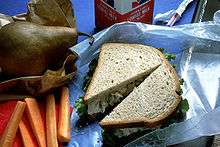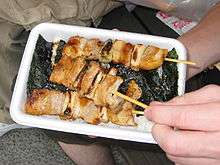Packed lunch
A packed lunch (also called pack lunch, sack lunch or bag lunch in North America, or pack up in parts of the United Kingdom, as well as the regional variations: packed lunch in Lancashire, Merseyside and Yorkshire, [1]) is a lunch prepared at home (or elsewhere, e.g. by a hotel for its guests; or perhaps, e.g. in Japan, sold in a vending machine) and carried to be eaten elsewhere, such as school, a workplace, or on an outing.


Technique
The food is usually wrapped in plastic, aluminum foil, or paper and can be carried ("packed") in a lunchbox, paper bag (a "sack"), or plastic bag. While packed lunches are usually taken from home by the people who are going to eat them, in Mumbai, India, tiffin boxes are most often picked up from the home and brought to workplaces later in the day by so-called dabbawallas. It is also possible to buy packed lunches from stores in several countries. Lunchboxes made out of metal, plastic or vinyl are popular. Lunch boxes provide a way to take heavier lunches in a sturdier box or bag. It is also environmentally friendly.
In Norway, a very widespread tradition of packing a lunch, called a matpakke, developed out of a free meal programme for schoolchildren instituted in the 1930s, called the Oslo breakfast. Norwegians have only half an hour for lunch and the matpakke is characteristically simple, somewhat boring open faced sandwiches of wholewheat bread packaged in wax paper and separated with smaller sheets of wax paper called mellomleggspapir. It can be eaten quickly allowing the rest of the lunch period to be used to relax.[2]
In the United States, an informal meeting at work, over lunch, where everyone brings a packed lunch, is a brown-bag lunch or colloquially a "brown bag".
In politics
One such brown bag lunch was used as a deliberate rebuff of the Chinese hosts, by the United States delegation, at peace negotiations in Kaesong during the Korean War. The Chinese hosts offered lunch and watermelon to the U.S. guests, which the U.S. delegates, who considered lunching with one's opposition to be fraternizing with the enemy, rejected in favor of their own packed lunches.[3]
See also
- Airline meal, often a pre-packaged meal
- Bento
- Dosirak
- Lunchbox
- Ploughman's lunch
- Tiffin
- TV dinner
References
| Wikivoyage has a travel guide for Packed food. |
- "BBC: Lancashire > Voices > Wordly Wise?". BBC. 31 May 2005. Retrieved 1 April 2014.
- Zaria Gorvett (3 January 2019). "Capital: The Norwegian art of packed lunch". BBC.
- Alfred D. Wilhelm, Jr. (1995). The Chinese at the Negotiating Table: Style and Characteristics. DIANE Publishing. p. 128. ISBN 0-7881-2340-8.